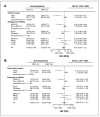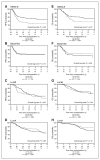Responsiveness of intrinsic subtypes to adjuvant anthracycline substitution in the NCIC.CTG MA.5 randomized trial
- PMID: 22351696
- PMCID: PMC3743660
- DOI: 10.1158/1078-0432.CCR-11-2956
Responsiveness of intrinsic subtypes to adjuvant anthracycline substitution in the NCIC.CTG MA.5 randomized trial
Abstract
Purpose: Recent studies suggest that intrinsic breast cancer subtypes may differ in their responsiveness to specific chemotherapy regimens. We examined this hypothesis on NCIC.CTG MA.5, a clinical trial randomizing premenopausal women with node-positive breast cancer to adjuvant CMF (cyclophosphamide-methotrexate-fluorouracil) versus CEF (cyclophosphamide-epirubicin-fluorouracil) chemotherapy.
Experimental design: Intrinsic subtype was determined for 476 tumors using the quantitative reverse transcriptase PCR PAM50 gene expression test. Luminal A, luminal B, HER2-enriched (HER2-E), and basal-like subtypes were correlated with relapse-free survival (RFS) and overall survival (OS), estimated using Kaplan-Meier plots and log-rank testing. Multivariable Cox regression analyses determined significance of interaction between treatment and intrinsic subtypes.
Results: Intrinsic subtypes were associated with RFS (P = 0.0005) and OS (P < 0.0001) on the combined cohort. The HER2-E showed the greatest benefit from CEF versus CMF, with absolute 5-year RFS and OS differences exceeding 20%, whereas there was a less than 2% difference for non-HER2-E tumors (interaction test P = 0.03 for RFS and 0.03 for OS). Within clinically defined Her2(+) tumors, 79% (72 of 91) were classified as the HER2-E subtype by gene expression and this subset was strongly associated with better response to CEF versus CMF (62% vs. 22%, P = 0.0006). There was no significant difference in benefit between CEF and CMF in basal-like tumors [n = 94; HR, 1.1; 95% confidence interval (CI), 0.6-2.1 for RFS and HR, 1.3; 95% CI, 0.7-2.5 for OS].
Conclusion: HER2-E strongly predicted anthracycline sensitivity. The chemotherapy-sensitive basal-like tumors showed no added benefit for CEF over CMF, suggesting that nonanthracycline regimens may be adequate in this subtype although further investigation is required.
©2012 AACR.
Conflict of interest statement
Figures



References
-
- Rouzier R, Perou CM, Symmans WF, Ibrahim N, Cristofanilli M, Anderson K, et al. Breast cancer molecular subtypes respond differently to preoperative chemotherapy. Clin Cancer Res. 2005;11:5678–85. - PubMed
-
- Carey LA, Dees EC, Sawyer L, Gatti L, Moore DT, Collichio F, et al. The triple negative paradox: primary tumor chemosensitivity of breast cancer subtypes. Clin Cancer Res. 2007;13:2329–34. - PubMed
-
- Conforti R, Boulet T, Tomasic G, Taranchon E, Arriagada R, Spielmann M, et al. Breast cancer molecular subclassification and estrogen receptor expression to predict efficacy of adjuvant anthracyclines-based chemotherapy: a biomarker study from two randomized trials. Ann Oncol. 2007;18:1477–83. - PubMed
Publication types
MeSH terms
Substances
Supplementary concepts
Grants and funding
LinkOut - more resources
Full Text Sources
Other Literature Sources
Medical
Research Materials
Miscellaneous

